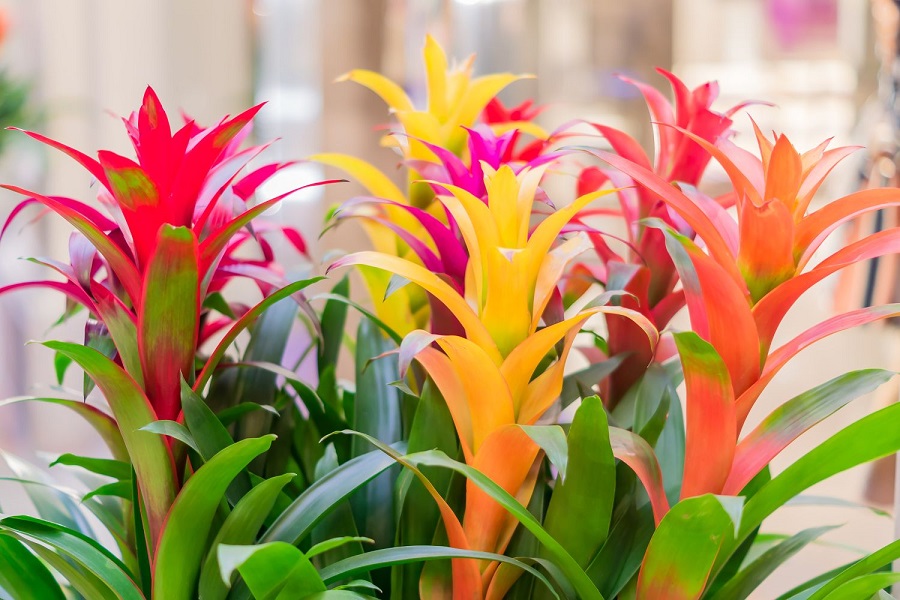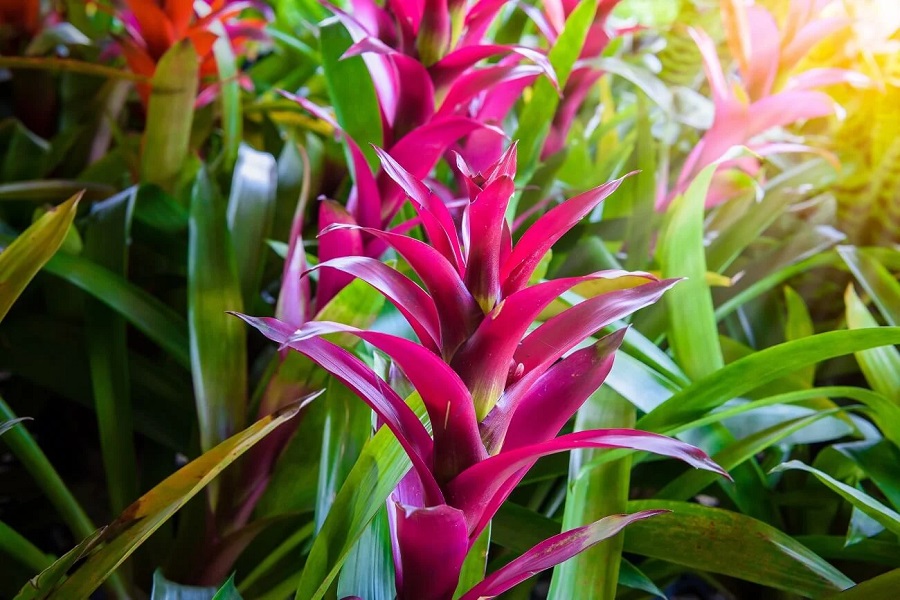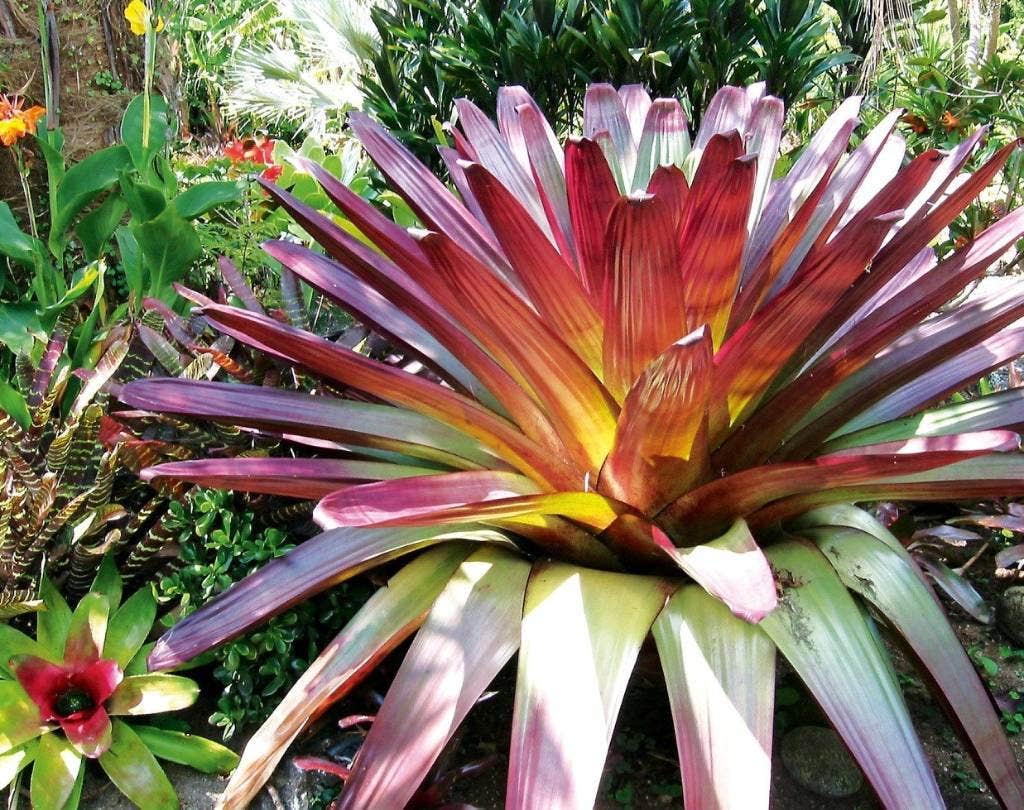Exotic Bromeliad - Care, Types of Bromeliad and Watering Explained
Bromeliad is an exceptionally fascinating plant of quite exotic appearance. It's a common decoration of home interiors. How to take care of this unusual houseplant? What conditions does it need? Where does it come from? Discover the secrets of bromeliad care and enjoy its beautiful looks.

Bromeliad – what kind of plant is it?
Bromeliad is also known by its scientific name Bromeliaceae. About 1600 different varieties of this plant grow in their natural habitat. It can be found mostly in North and South Americas. Bromeliads grow in various conditions, depending on the variety. Most of them appear on trees as epiphytes, although there are also exceptions as well.

Popular types of bromeliads
The most popular bromeliad varieties include Guzmania and Vriesea. Both houseplants are often compared to each other. As for guzmania, its flower resembles a fountain. Vriesea forms a much flatter flower.
In both cases, the leaves of the plant are smooth, and their color is rich green. There are also varieties with multi-colored leaves. Most importantly, these plants have different heights and colors of their flowers.
Other popular types of bromeliads include:
- Aechmea,
- Tilandsia.
Aechmea is one of the oldest varieties. Unlike other bromeliads, it has characteristic serrated leaves. Aechmea Primera has been quite popular recently because of its pink inflorescence. There are also varieties of white, red, orange, and double colored flowers.
Tilandsia is another bromeliad variety you can easily cultivate at home. Pink quill is the most commonly known plant from this family, also known as Tillandsia cyanea. Its pink plume with blue flowers it’s the biggest advantage of this plant.

Bromeliad – houseplant care
Potted bromeliad is very easy to maintain. Many beginner gardeners think its colorful leaves are flowers. In fact, these elements simply change their color from green as they grow upwards. Flowers appear in between the leaves.
The possibility of blooming during any season is the biggest advantage of growing a potted bromeliad. This process depends mostly on the development of the plant’s plume. But note that blooming of the plant means its inevitable end. After a relatively long blooming period which lasts from three to six months, the plant dies back and dries. Those who begin their gardening adventure shouldn’t be discouraged – it’s completely natural.

Bromeliad – care and watering
Are you wondering how to take care of a bromeliad? Water the plant at least once a week. The leaves also require quite frequent misting. Keep in mind what water you’re using. It should be soft – if you use hard water, expect an ugly residue on the leaves’ surface.
The key to keeping the plant in the best condition is placing it in the right location. The place should be partially sunny. Also, remember about the right temperature. The plant feels great in 22-24°C (71.6-75.2°F).
You can put the bromeliad on a balcony or patio in summer. But note that if the temperatures drop, you have to take care of it and move it either back home or to a warmer spot. The temperature cannot be below 20°C (68°F). A colder temperature and too much water might cause issues – including rotting of the roots.
Bromeliads belong to the group of plants that dislike dry air. Because of this, avoid placing the plant next to a radiator. The plant also doesn’t react well to drafts. Make sure to protect it from this danger as well.

Bromeliad – blooming
When a bromeliad starts blooming, it’s a signal for the plant’s owner that its life is about to end. After a long blooming period, the plant dries and dies. It’s a natural process which cannot be stopped. But after the plant dries, you can retrieve seedlings and regrow them.
Bromeliad – propagation
Bromeliad propagation is the natural course of events after it finishes blooming. When the plant dies back, make sure to cut off the dry parts and observe the container carefully. In place of the old bromeliad, new “pups” should appear. If they grow enough, you can put them in new pots and take care of the plant again.

Bromeliad – pests and dangers
Bromeliad is a very resistant plant which can endure changing conditions – except for low temperatures. Only a weakened plant, or the one with damaged leaves can become a target for pests. That’s why it’s so important to take care of fertile soil and handle the plant with caution.
As for potential pests, not all bugs attack the plant. Spider mites, mealybugs, and thrips are the most common ones. If they appear, make sure to use an appropriate chemical to get rid of the unwanted guests. If the infestation is at its initial stage, you can also try some homemade repellents. Garlic- and onion-based brews are the most popular solutions.

What are the common diseases of bromeliads?
Bromeliads are durable plants. If any diseases attack them, it’s usually a result of taking an improper care of the plant. Browning leaves is the most common issue. It’s a problem of overheated plants which were exposed to intense sunlight for a long time.
Sometimes the plant’s root system might rot. It happens as a result of overwatering the plant.

📍 How long do bromeliads bloom?
Bromeliad flowers are considered one of the most beautiful among all houseplants. Keep in mind that the plant blooms only once during its entire life – just like agave. Depending on the conditions provided to the plant, it can bloom from three to six months.
📍 How to water bromeliad?
Bromeliad leaves have special hair and points – the plant uses them to retrieve water and other necessary nutrients. Water the soil only slightly, typically once a week. If the plant is flowering, you can mist it with water from time to time.
📍 What is the best soil for a bromeliad?
Growing a bromeliad is relatively simple – but the plant needs good soil. You can use store-bought mixes for houseplants and additionally mix it with sand. Make sure to take care of a drainage layer at the bottom, so the soil is permeable.
📍 What to do with bromeliad after blooming?
Are you wondering what to do when your bromeliad finishes blooming? Propagation is the next natural step. First, remove the brown stems of the plant. If the bromeliad grew in good conditions, it's likely it developed new pups. They will grow into new plants.
Featured articles




